
Aristide Cavaillé-Coll was a French organ builder. He has the reputation of being the most distinguished organ builder of the 19th century. He pioneered innovations in the art and science of organ building that permeated throughout the profession and influenced the course of organ building, composing and improvising through the early 20th century. As the author of scientific journal articles about the organ construction details, he published the results of his research and experiments. He was the inventor of the symphonic organ being able to follow smooth and immediate dynamic changes like a symphonic orchestra. This goal was reached by: a) invention of harmonic flue and reed stops, such as the flûte harmonique, trompette harmonique, clairon harmonique, b) invention of divided windchest with 2-3 different wind pressure sections, c) creation of groups of stops allowing for fast dynamics changes without taking hands out of the keyboards by the organist, d) organ specification planning on the base of 'orchestral quartet". His most famous organs were built in Paris in Saint-Denis Basilica (1841), Église de la Madeleine, Sainte-Clotilde Basilica (1859), Saint-Sulpice church, Notre-Dame Cathedral, baron Albert de L'Espée's residence in Biarritz, and many others. After Cavaillé-Coll's death, Charles Mutin maintained the business into the beginning of the 20th century. The organ reform movement in the 20th century sought to return organ building to a more Baroque style; but since the 1980s, Cavaillé-Coll's designs have come back into fashion.

An electric organ, also known as electronic organ, is an electronic keyboard instrument which was derived from the harmonium, pipe organ and theatre organ. Originally designed to imitate their sound, or orchestral sounds, it has since developed into several types of instruments:

A pedalboard is a keyboard played with the feet that is usually used to produce the low-pitched bass line of a piece of music. A pedalboard has long, narrow lever-style keys laid out in the same semitone scalar pattern as a manual keyboard, with longer keys for C, D, E, F, G, A and B, and shorter, raised keys for C♯, D♯, F♯, G♯ and A♯. Training in pedal technique is part of standard organ pedagogy in church music and art music.
Ronald William Sharp was an Australian organ builder. He was awarded the Silver Jubilee Medal (1977) and the British Empire Medal (1980).
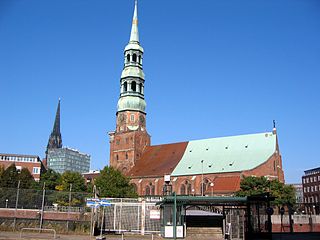
St. Catherine's Church is one of the five principal Lutheran churches (Hauptkirchen) of Hamburg, Germany. The base of its spire, dating from the 13th century, is the second oldest building preserved in the city, after the lighthouse on Neuwerk island. It is situated on an island near what was formerly the southern boundary of the medieval city, opposite the historic harbour area on the Elbe river. It traditionally served as the church of the seamen.

Doncaster Minster, formally the Minster and Parish Church of St George, is the Anglican minster church of Doncaster, South Yorkshire, England. It is a grade I listed building and was designed by architect designer George Gilbert Scott. The church was built in 1854–1858 to replace an earlier building destroyed by fire. It is an active place of worship and has a Schulze organ, a ring of eight bells, and a celebrated clock by Dent. The church is one of two parish churches to have minster status in South Yorkshire. The other is the minster church of Rotherham.

Gottfried Silbermann was a German builder of keyboard instruments. He built harpsichords, clavichords, organs, and fortepianos; his modern reputation rests mainly on the latter two.
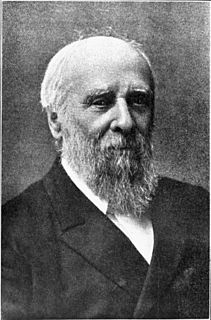
Henry Willis, also known as "Father" Willis, was an English organ player and builder, who is regarded as the foremost organ builder of the Victorian era. His company Henry Willis & Sons remains in business.
The 17th century organ composers of Germany can be divided into two primary schools: the north German school and the south German school. The stylistic differences were dictated not only by teacher-pupil traditions and international influences, but also by separate organ building traditions: northern organs tend to have a tower layout with emphasis on the pedal division, while southern and Austrian instruments are typically divided around a window and emphasize manual divisions.

The pipe organ is played from an area called the console or keydesk, which holds the manuals (keyboards), pedals, and stop controls. In electric-action organs, the console is often movable. This allows for greater flexibility in placement of the console for various activities. Some very large organs, such as the van den Heuvel organ at the Church of St. Eustache in Paris, have more than one console, enabling the organ to be played from several locations depending on the nature of the performance.
Friedrich Krebs was an early German organ builder. He was born in Schalkhausen, a small village near Ansbach, and worked in Franconia from about 1471. He was one of several important German organ builders of the time who contributed to the transition from the gothic Blockwerk organ to organs with several divisions and independent stops. He also extended the range of keyboards and pedalboards from B to f" to F to a" (manuals) and from A to a to F to c' (pedals). Churches he provided instruments for include the following:

Gdańsk Oliwa Archcathedral is a church in Gdańsk, Oliwa, Poland that is dedicated to The Holy Trinity, Blessed Virgin Mary, and St. Bernard.

Basilica of St Patrick is a Roman Catholic church located on Adelaide Street in Fremantle, Western Australia. It is one of five churches in Australia with minor basilica status.
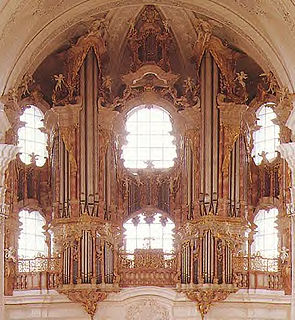
The organ at the Basilica of St. Martin (Weingarten), the monastery church of the Weingarten Abbey was built by Joseph Gabler between 1737 and 1750. In addition to the large organ he also built the small choir organ in 1743, but this has since been renovated or completely rebuilt.
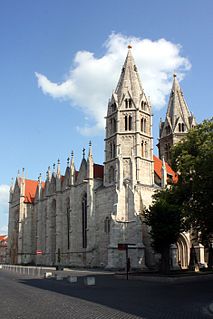
Divi Blasii is a Gothic church in the Thuringian town of Mühlhausen, central Germany. Besides St. Mary's, it is one of Mühlhausen's two principal churches.
Alexandre Thierry was a French organ builder, son of the organ builder Pierre Thierry, and the most distinguished of the second generation of this organ-building dynasty.
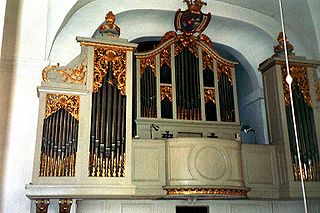
Johann Lorenz Bach was a German organist and composer of the franconian branch of the Bach family.

Casavant Frères Ltée. Opus 1841 is a pipe organ built by the famous Casavant Frères of Saint-Hyacinthe, Quebec. The organ was first completed in 1911 as Casavant Brothers - Opus 452 for St. Andrew's Presbyterian Church at 40 Bentinck Street, Sydney, Nova Scotia, Canada. St. Andrew's later became St. Andrew's United Church and is now the Highland Arts Theatre.

St Paul's Anglican Church and Pipe Organ is a heritage-listed Anglican church building and pipe organ located at 205 Burwood Road in the Sydney suburb of Burwood in the Municipality of Burwood local government area of New South Wales, Australia. The church was designed by Edmund Blacket and the organ was designed by William Davidson, with some consultation from Montague Younger. The church and organ were built from 1889 to 1891. The church is also known as St. Paul's Anglican Church and Pipe Organ, St Paul's Anglican Church and Davidson Pipe Organ. The property is owned by Anglican Church Property Trust. It was added to the New South Wales State Heritage Register on 2 April 1999.

The organ of St. Peter and Paul in Cappel was built in 1680 by Arp Schnitger for the St. Johannis-Klosterkirche in Hamburg and has been in Cappel, Lower Saxony since 1816. It is considered to be the most complete and sonically best-preserved organ from the late 17th century in northern Germany. The instrument has two manuals with pedal and 30 stops, of which only two are not entirely old. Helmut Walcha's recordings of Bach's organ works (1950–1952) made this instrument world-famous.















